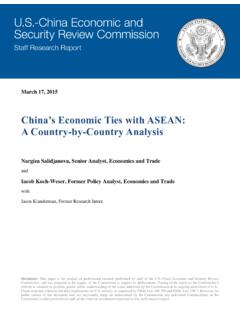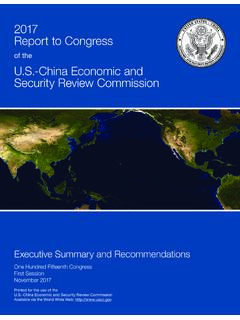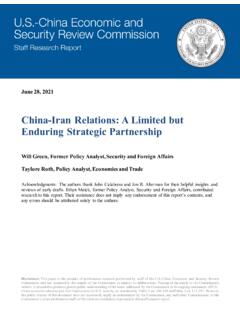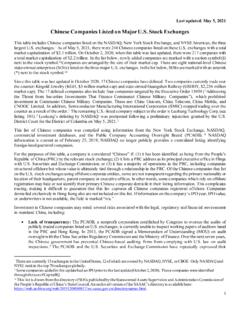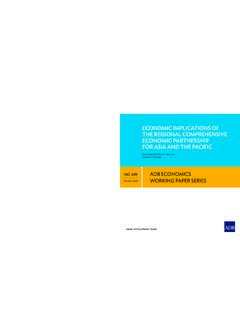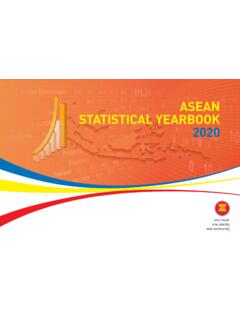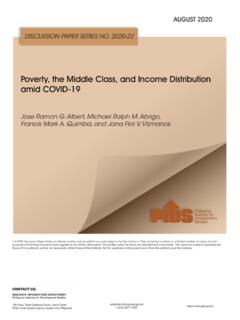Transcription of South China Sea Arbitration Ruling: What Happened and …
1 July 12, 2016 economic and Security Review Commission 1 South China Sea Arbitration Ruling: What Happened and What s Next? Caitlin Campbell, Senior Policy Analyst, Security and Foreign Affairs Nargiza Salidjanova, Senior Policy Analyst, Economics and Trade Key Findings The arbitral tribunal adjudicating the Philippines case against China in the South China Sea ruled overwhelmingly in favor of the Philippines, determining that major elements of China s claim including its nine-dash line, recent land reclamation activities, and other activities in Philippine waters were unlawful. Predictably, China reacted negatively to the ruling, maintaining it was null and void.
2 China may take assertive and inflammatory steps to defend its position. The extent to which China abides by the ruling in the long term, and to which the international community supports and seeks to enforce the ruling, will have consequences for the utility of international law as a tool to ensure the peaceful, stable, and lawful use of the seas going forward. Background On July 12, 2016, the Permanent Court of Arbitration in The Hague released the ruling of the arbitral tribunal constituted under the UN Convention on the Law of the Sea (UNCLOS)* on the case initiated by the Philippines in 2013 regarding China s claims and activities in the South China At the center of the dispute is China s nine-dash line, a vague depiction by China of its claim encompassing about 90 percent of the South China Since around 2009, China has steadily increased its efforts to consolidate its position in the South China Sea with varied tactics, including using its military, coast guard, and maritime militia to harass foreign ships.
3 Exploring and extracting resources in disputed areas; and, starting in 2013, constructing artificial islands and basing military and civilian assets there. * Both China and the Philippines have ratified UNCLOS. The United States has not. China has the world s largest maritime militia, a quasi-military force of fishermen that are tasked by and report to China s People s Liberation Army. They are trained to participate in a variety of missions, including search and rescue, reconnaissance, deception operations, law enforcement, and rights protection, which often entails activities like harassing foreign vessels in China s claimed waters.
4 Andrew Erickson and Conor M. Kennedy, China s Fishing Militia is a Military Force in all but Name, War is Boring (Blog), July 9, 2016. #.6t8u2b104. economic and Security Review Commission 2 Figure 1: Map of the South China Sea Source: Economist, Joining the Dashes, October 4, 2014. Economically, diplomatically, and militarily outmatched by China , the Philippines turned to legal Arbitration . The Philippines case, comprised of thousands of pages of arguments and documents, asked the court, among other things, to (1) declare whether China s claims based on the nine-dash line are invalid under UNCLOS; (2) declare whether certain land features in the South China Sea are rocks, islands, or low-tide elevations;* and (3) declare whether China has interfered with the Philippines right to exploit resources within the Philippines claimed Over the past three and a half years, China has expended resources and energy to discredit the Philippines case and the legitimacy of the proceedings, arguing that it would neither accept nor participate in the Arbitration .
5 4 In the months leading up to the ruling in particular, Beijing began a campaign of diplomatic warfare5 to solicit support from other countries for its position, and suggested in mid-June that 60 countries had pledged support to China s position,6 though in reality only ten countries made public statements to that effect. 7 The Chinese government and government-affiliated entities also placed advertisements and editorials in overseas media outlets, including the United States Washington Post8 and San Francisco Chronicle,9 the UK s Telegraph,10 and Australia s The Age,11 supporting Beijing s stance on the Arbitration . At a think tank event in Washington, DC one week before the ruling, * The distinction, as defined by UNCLOS, between an island, rock, and low-tide elevation is important because each type of feature generates a different amount of maritime territory.
6 Islands, which must be above water at high tide and be capable of sustaining human habitation or economic activity of their own, can generate exclusive economic zones out to 200 nautical miles. (An exclusive economic zone is a 200-nm zone extending from a country coastline within which that country can exercise exclusive sovereign rights to explore for and exploit natural resources, but not full sovereignty.) Rocks, which are defined as being above water at high tide but unable to sustain human habitation or economic activity, only generate a 12-nm territorial sea. Low-tide elevations are land features which are submerged at high tide. Unless they are located within the territorial sea of another island or mainland coastline, they do not generate any maritime territory.
7 UN Convention on the Law of the Sea, Article 121: Regime of Islands; UN Convention on the Law of the Sea, Part 2: Territorial Sea and Contiguous Zone; and UN Convention on the Law of the Sea, Part 5: Exclusive economic Zone. These countries are Afghanistan, The Gambia (which formally restored diplomatic ties with China in March 2016 after severing diplomatic relations with Taiwan in 2013), Kenya, Lesotho, Liberia, Niger, Papua New Guinea, Sudan, Togo, and Vanuatu. Center for Strategic and International Studies Asia Maritime Transparency Initiative, Arbitration Support Tracker, June 15, 2016. economic and Security Review Commission 3 China s former top diplomat Dai Bingguo remarked that the ruling would amount to nothing more than a piece of paper.
8 12 Through diplomatic pressure and economic leverage China has also succeeded in preventing other South China Sea claimants from rallying in opposition to China s activities or in support of the legal Arbitration process. Members of the association of southeast asian nations ( asean ) five of whom have claims in the South China Sea have failed to endorse a joint plan of action. The June 2016 meeting of asean foreign ministers ended in discord after they issued and then retracted a joint communique expressing concerns over recent developments in the South China Sea allegedly due to Chinese The Ruling: Key Takeaways The Permanent Court of Arbitration s 479-page ruling14 was overwhelmingly favorable to the Philippines position, ruling several elements of China s claims in the South China Sea unlawful.
9 Key findings of the ruling include: China s claims to historic rights and resources within its nine-dash line have no legal None of China s claimed land features in the Spratly Islands are an island capable of generating a 200-nm exclusive economic zone.*16 China violated the Philippines sovereign rights by interfering with Philippine oil exploration activities, prohibiting Philippine fishing vessels from operating, failing to prevent Chinese fishing vessels from operating, and conducting land reclamation in areas where the Philippines enjoys sovereign rights to explore for and exploit natural resources. 17 China violated its marine environmental protection obligations under UNCLOS by causing severe harm to the coral reef environment with its land reclamation activities and harvesting of endangered China is legally bound by the tribunal s ruling by virtue of its ratification of The extent to which, and how, the tribunal s ruling might be enforced is an open question, however; the Philippines and others may be able to pursue a range of legal options to punish China should it fail to abide by the ruling,20 or open negotiations to resolve the matter.
10 China s Response China s immediate reaction to the ruling was to release two statements: a notably subdued Government statement that reaffirmed its territorial sovereignty and maritime rights in the South China Sea and expressed its desire to resolve the relevant disputes peacefully without making explicit reference to either the Philippines or the Arbitration proceedings,21 and a much more hardline statement from the Ministry of Foreign Affairs declaring that * The tribunal ruled that China s claimed features are either rocks (capable of generating a 12-nm territorial sea) or low-tide elevations (incapable of generating maritime territory).
